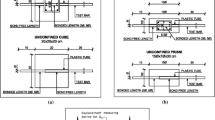Abstract
The force transfer between concrete and reinforcement depends on the bond characteristics between the two materials. Bond influences crack widths and the deflections of RC members and also determines anchorage and splice lengths. Self-compacting concrete (SCC) is characterized by a smaller amount of coarse aggregates when compared to conventional vibrated concrete. To investigate whether this change in mix design has a significant influence on the bond behaviour, a series of beam tests (according to RILEM recommendation RC6) was performed. A total of 36 specimens were cast using 3 different concrete types: one conventional vibrated concrete (CVC) and two powder-type SCC’s. The bond stress—slip behaviour of reinforcing bars with diameters ranging from 12 to 40 mm has been recorded. From these tests, it can be concluded that the bond strength of SCC is even higher than it is for CVC for small bar diameters, but the difference becomes smaller for larger bar diameters.











Similar content being viewed by others
Abbreviations
- ϕ:
-
Reinforcement bar diameter, mm
- σs :
-
Tensile stress in the reinforcing bar, N/mm2
- τM :
-
Characteristic value of the bond strength, N/mm2
- τR :
-
Ultimate bond strength, N/mm2
- τR,n :
-
Normalised ultimate bond strength, N/mm2
- CVC:
-
Conventional vibrated concrete
- DEV:
-
Standard deviation
- f c :
-
Concrete compressive strength, N/mm2
- f ccub :
-
Concrete cube compressive strength, N/mm2
- f ct,fl :
-
Concrete flexural tensile strength, N/mm2
- f ct,sp :
-
Concrete splitting tensile strength, N/mm2
- f R :
-
Relative rib area of a reinforcing bar
- f u :
-
Ultimate tensile strength of a reinforcing bar, N/mm2
- f y :
-
Yield strength of a reinforcing bar, N/mm2
- F s :
-
Total tensile force in a reinforcing bar, N
- k :
-
Bond length expressed as ‘times the bar diameter ϕ’
- l d :
-
Bond length, mm
- P :
-
Total load applied during the test, N
- SCC:
-
Self-compacting concrete
- s u :
-
Slip corresponding to the ultimate bond strength, mm
References
Martin H (2002) Bond performance of ribbed bars (Pull-Out-Tests)—influence of concrete composition and consistency. In: Proceedings of the 3rd international symposium: bond in concrete—from research to standards, Budapest, pp 289–295
De Schutter G, Boel V (eds) (2007) In: Proceedings of the 5th international RILEM symposium on self-compacting concrete, RILEM Proceedings PRO54, RILEM Publications
De Schutter G, Bartos P, Donome P, Gibbs J (2008) Self-compacting concrete. Whittles Publishing, Caithness, p 296
Menezes de Almeida Filho F et al (2008) Bond-slip behavior of self-compacting concrete and vibrated concrete using pull-out and beam tests. Mater Struct 41:1073–1089
Chan Y, Chen Y, Liu Y (2003) Development of bond strength of reinforcement steel in self-consolidating concrete. ACI Struct J 100(4):490–498
Zhu W, Sonebi M, Bartos PJM (2004) Bond and interfacial properties of reinforcement in self-compacting concrete. Mater Struct 37:442–448
Dehn F, Holschemacher K, Weiβe D (2000) Self-compacting concrete (SCC) time development of the material properties and the bond behaviour, LACER, no. 5
RILEM (1973) Technical recommendations for the testing and use of construction materials: RC6, bond test for reinforcing steel: 2. Pull-out test, materials and structures
RILEM (1973) Technical recommendations for the testing and use of construction materials: RC6, bond test for reinforcing steel: 1. Beam test, materials and structures, pp 96–105
ISO (2002) ISO 15630-1:2002(E) Steel for the reinforcement and prestressing of concrete—test methods—part 1: reinforcing bars, wire rod and wire, ISO, p 15
Acknowledgements
The authors would like to acknowledge the Fund for Scientific Research in Flanders (FWO) for the financial support of the research project.
Author information
Authors and Affiliations
Corresponding author
Rights and permissions
About this article
Cite this article
Desnerck, P., De Schutter, G. & Taerwe, L. Bond behaviour of reinforcing bars in self-compacting concrete: experimental determination by using beam tests. Mater Struct 43 (Suppl 1), 53–62 (2010). https://doi.org/10.1617/s11527-010-9596-6
Received:
Accepted:
Published:
Issue Date:
DOI: https://doi.org/10.1617/s11527-010-9596-6




